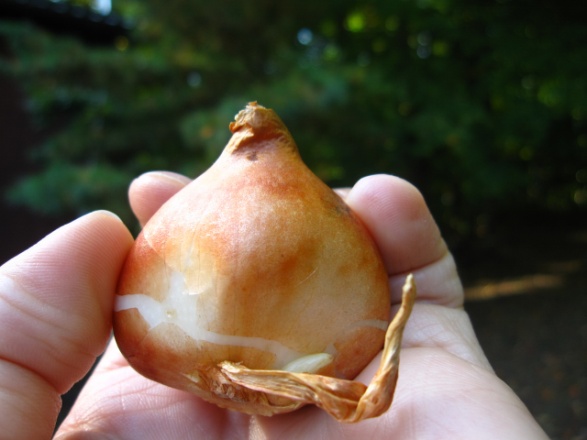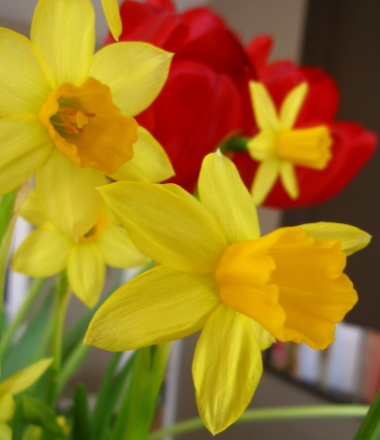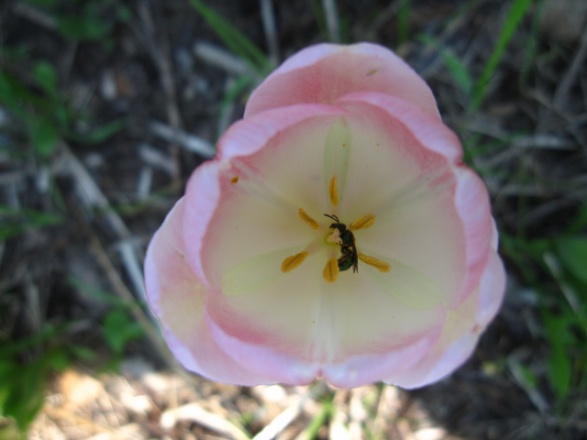It’s A-Bulb Time
Last week on Canada AM), Jeff and I gave you advice on planting bulbs. For some, the idea of planting bulbs before the freezing temperatures of winter seems counterintuitive. But, trust me, your late season prep work now will provide you a beautiful show in the spring. And who doesn’t love to see the bright green of new spring shoots after a long season of powdery white snow covering just about everything.

The Basics
I won’t go over the basics too much today (I did that enough in the video) but spacing and depth are important so I will repeat them.
Depth: three times the length of the bulb. If the bulb is longer (from tip to base, not side to side), it will be planted deeper.
Spacing: will vary but plan on at least 2cm between bulbs. I tend to plant mine in clumps of 5 bulbs, keeping them spaced evenly.
Direction: plant with the pointed side up. This is where the green shoots will sprout and the flatter bottom side is where the roots will grow from.

Like I said in the video, you can layer different bulbs for a greater affect. Just be sure to plant the largest bulbs at the bottom and the smallest on top (keeping with the 3x width rule I mentioned earlier).
Holland Bulb Booster
Bulbs need food just like any other plant. With the right combination of nitrogen, phosphorous, and potassium, Holland Bulb Booster will give your flowering bulbs deeper green foliage and flowers that last longer. Fertilize the bulbs when you’re planting in the fall and as you see fit afterwards. If you notice they are lacking in their usual luster, sprinkle some Bulb Booster on them after flowering has finished to promote healthier bulbs next season.

Animal-Proofing
Deer and squirrels are a problem in a number of areas across Canada. Squirrels will dig up bulbs in the fall and the spring before they have emerged. Deer will decimate foliage as it starts to appear when the snow melts.
Look for deer and squirrel resistant bulbs (like the Mark’s Choice ones below) or try your hand at animal-proofing using any number of the strange concoction recipes around. I cannot recommend any particular one as I have found deer are as diverse in their tastes as the concoctions made to repel them. Your best bet is to ask around your local area for advice on what works for the animals that live around you.
Try animal-proofing with chicken wire laid across the surface where your bulb is buried. This is best for squirrels and can be removed in the spring when the bulb starts to sprout. If you use chicken wire with wide holes, you don’t need to remove it as the foliage will grow between the wires.
Mulch is also effective in some areas as it creates a larger barrier between the squirrel and the bulb. Again, because it’s a barrier for the bulb and not the plant, it probably won’t be that effective for deer.
Finally, mix in a few alliums with animal favourites. Alliums are generally avoided and can be an effective deterrent when it comes to squirrels and deer.
My Own Line of Bulbs
If you’re familiar with my work at Home Hardware, you may know that I have recently introduced some plants to the Mark’s Choice line-up. Check out these for a stunning variety in the garden:
100 Days of Flowers
Deer and Squirrel Resistant Bulbs
Bee-Friendly Bulb Collection
Spend some time this fall planting bulbs and enjoying the fresh autumn air. If you’re anything like me, you’ll have forgotten about them in the spring until the snow has just about driven you mad – and then you’ll see those tiny green shoots, reminding you that spring is on its way.




